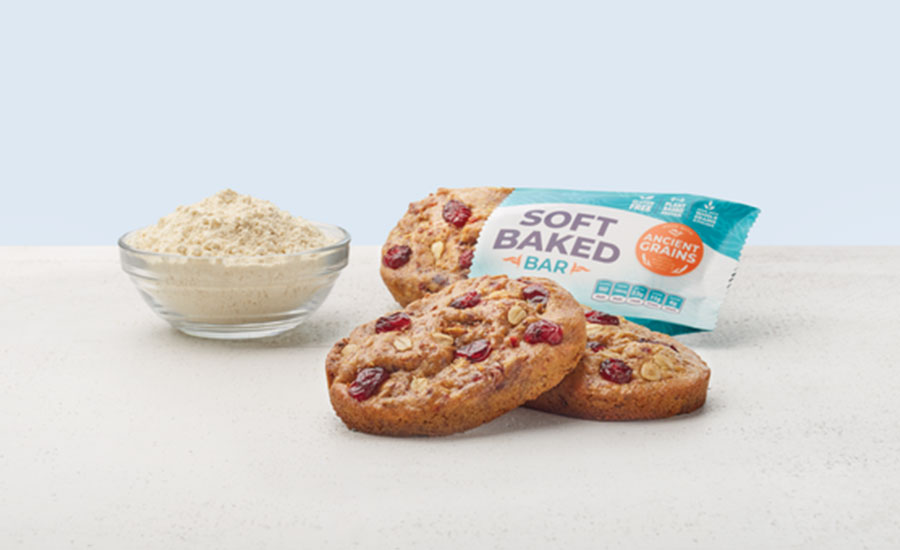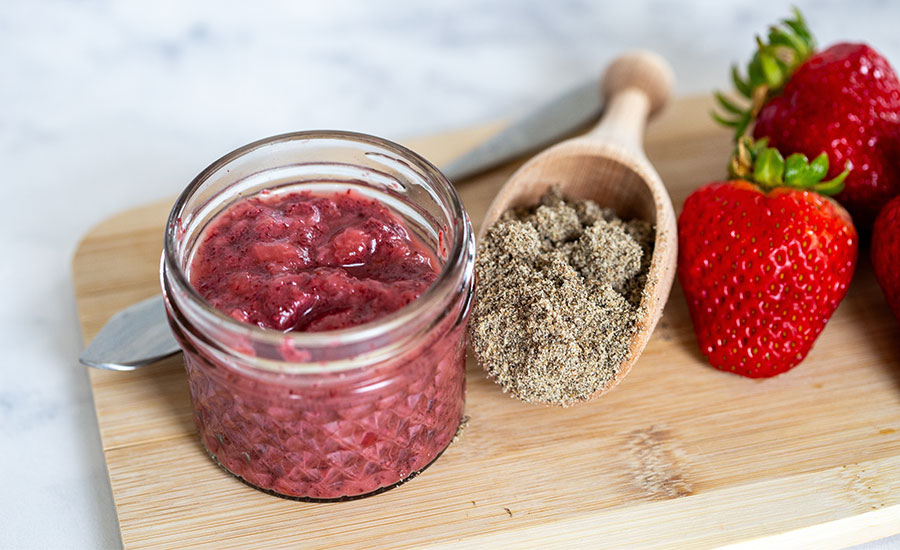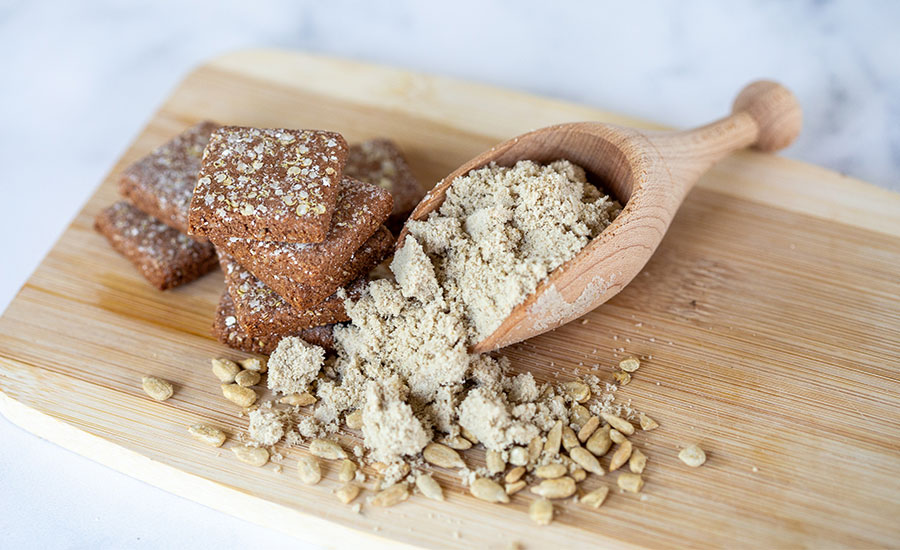Grains deliver health benefits, versatility, and taste
Snack and bakery consumers enjoy a mix of traditional and new ingredients.

Courtesy of Highland Specialty Grains
The Bottom Line:
- Producers appreciate the versatility of grains
- Consumers are interested in trying ancient grains and other less-familiar products
- Several grains offer appealing functionality benefits
Grains are a fundamental ingredient in bakery and snack food products that can provide flavor, texture, nutrition, and functional benefits. What’s more, there exists a multitude of different grains to choose from, depending upon the product needs.
According to ADM proprietary research shared by Paula LaBine, ADM’s marketing director for milling and baking solutions, familiar ingredients are influencing consumers’ purchasing decisions.
“For example, quinoa, chia, flaxseed, and barley are grains consumers are most familiar with and have tried, so they are good alternative options that work well for bread, bars, and snacks,” says LaBine. “Sorghum and millet are two other grains that consumers seek, particularly when looking for alternatives that are gluten-free and nutrient dense.”
LaBine notes that research has shown 63% of consumers globally are taking a proactive approach to health to focus on prevention, and there are a handful of grains to support those goals.
“Ancient grains like amaranth are beginning to make an appearance on consumer radars. The mild and nutty flavors of teff help fortify pizza crusts, pastas, and snacks with protein,” she points out. “Amaranth can also be blended with quinoa easily for a consumer-friendly combination, and it contains sought-after omega-3 fatty acids.”
Starting with the seed
Highland Specialty Grains is a breeding company founded in 2013. The company develops new varieties of barley, wheat, buckwheat, and other specialty grains. They license the varieties and sell seeds to the famers and other seed companies; they also sell food barley and buckwheat to food processors. Brett Despain, specialty crops breeder and commercial manager with Highland Specialty Grains, says, “We continue to develop and release new varieties of barley, wheat, and other specialty grains which have higher percentages of desired nutrients along with higher yields and improved agronomic traits such as better disease resistance. The new varieties are also more tolerant of environmental stresses such as too little or too much rain.”
Despain notes that for food barley grown for Beta Glucan fiber, new varieties include BG Nitro. “BG Nitro is a variety with shrunken kernels, high Beta Glucan, waxy starch, and improved resistance against leaf rust. Another new variety, HO517-126, is a hulless barley with higher protein compared to conventional barley varieties grown for grain. The grain from these varieties are more nutrient-dense than previous varieties. There is also more yield per acre. Thus, production is more sustainable due to the use of less inputs per unit of production.”
Buckwheat is a gluten-free grain that the company also provides. “Our production and sales of buckwheat have increased. We continue to develop new varieties of buckwheat which are better for the farmers, food industry, and consumers,” shares Despain.
New grains cropping up
In response to growing consumer demand for better-for-you snacks and baked goods, Ardent Mills has launched two new grain-based ingredients. The first new product was designed to simplify formulations and increase quality protein levels in baked applications, shares Lindsey Morgan, senior director, product marketing and innovation, Ardent Mills.
“Ancient Grains Plus is precisely blended with gluten free whole grains including buckwheat, sorghum, amaranth, and quinoa to deliver a mild flavor for wide consumer appeal while also being flexible enough for savory and sweet applications like muffins, cookie, and biscuits,” Morgan relates.


Ardent Mills Egg Replace was developed to be a 1:1 replacement for dried whole eggs, notes Morgan. “Our team of culinary and R&D experts has seen success using the ingredient in applications like cookies, muffins, pancakes, and waffles thanks in part to the functional benefits of chickpea flour, one of four ingredients in Ardent Mills Egg Replace. Chickpea flour was a natural choice to replace eggs as it has certain functional properties such as the ability to whip into a foam, form a gel, and contribute to Maillard browning. Chickpea flour is also a more well-known ingredient with 94% of consumers stating they’re familiar with chickpea,” she adds.
Healthy Food Ingredients has launched two new products: a milled chia, and a milled sunflower kernel. Jennifer Tesch, chief marketing officer for the company, says, “Our milled sunflower kernel provides water absorption and creates a strong dough structure, along with the emulsion capacity needed to stabilize water-oil molecules.”
Milled sunflower kernel can be used in bread, cookies, and cracker applications. Milled chia boasts gelation and water absorption properties as well as a desirable mouthfeel notes Tesch. This ingredient is a great fit for energy bites, bars, and as an egg replacer in baked goods. Both new products are clean-label, better-for-you ingredients that fit gluten-free, keto, and vegan trends.
According to Keyla Rodriguez, technical service manager, Cargill, whole-grain corn ingredients still have a big role to play, even in formulations that also include trending ingredients like ancient grains.
“Whole-grain corn ingredients provide similar functionality to the standard corn flours, with the added nutritional benefits of higher protein, fiber, and fat. In bakery and snack applications, whole grain corn ingredients serve as a starch source, can contribute to structure and texture, and may serve as a carrier for seasonings,” Rodriguez states. “In snack products like chips, they serve as a base ingredient for extruded applications. They also bring an air of authenticity to products. For example, whole grain corn meal adds an artisanal flair to things like pizza crusts, providing a ‘gritty’ texture element.”


Whole-grain corn ingredients pair well with most any grain: wheat, sorghum, quinoa, teff, and other ancient grains. “We’ve also used it with chickpeas, beans, and other pulses; plus, it works great with all kinds of seasonings, from lime-jalapeno to black garlic,” Rodriguez says. “Whole-grain corn ingredients have a flavor profile and functionality that allow them to serve as the base for a wide range of products, flavors, and grains.”
Whole-grain corn ingredients are gluten-free and are a source of fiber that can help brands improve the nutrient density of their gluten free products. Cargill’s whole-grain corn ingredients work well in snack bars, chips, crackers, and cereal applications.
Gluten-free growth
All the companies noted that demand for gluten-free continues to grow and are providing innovative solutions to meet this need. Matt Schueller, director, marketing insights and analytics, Ardent Mills, notes that within the gluten-free sphere, alternative and emerging grains are rapidly growing in popularity since they are able to provide the taste, texture, and satisfaction of traditional bakery items, without gluten.
“If we look at the impact that the ingredient has on consumer purchasing intent, quinoa, chia, oat flour, buckwheat, sorghum, chickpea flour, and barley are taking the lead, according to Ardent Mills proprietary research,” Schueller notes. “We anticipate this to be fueled by consumers’ growing desire for healthier or perceived healthier options, the overall eating experience, and greater diversity in their diets. Additionally, these ingredients can do more than just take the place of gluten; they can also provide added benefits. Chickpea flour is a good source of fiber and other vitamins and minerals, and quinoa can be used to help add additional plant-based protein, fiber, and other vitamins and minerals.”
The range and uses of grains continues to grow to meet consumers’ diverse needs.Looking for a reprint of this article?
From high-res PDFs to custom plaques, order your copy today!





